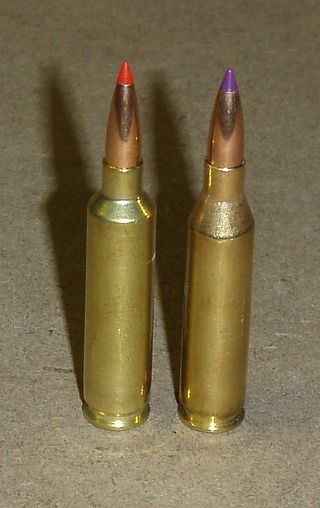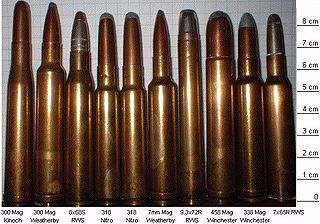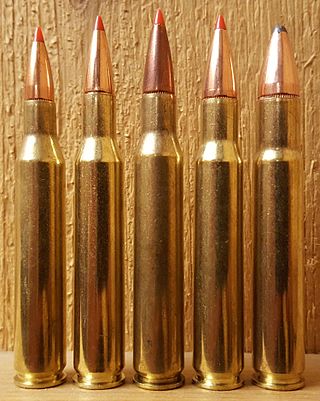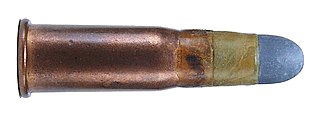
This is a list of firearm cartridges which have bullets in the 7.00 to 7.99 millimetres caliber range.

This is a list of firearm cartridges which have bullets in the 5.00 to 5.99 mm caliber range.

The .460 Weatherby Magnum is a belted, bottlenecked rifle cartridge, developed by Roy Weatherby in 1957. The cartridge is based on the .378 Weatherby Magnum necked up to accept the .458-inch (11.6 mm) bullet. The original .378 Weatherby Magnum parent case was inspired by the .416 Rigby. The .460 Weatherby Magnum was designed as an African dangerous game rifle cartridge for the hunting of heavy, thick skinned dangerous game.

The .22 Remington Jet is a .22 in (5.6mm) American centerfire revolver and rifle cartridge.

A wildcat cartridge, often shortened to wildcat, is a custom cartridge for which ammunition and/or firearms are not mass-produced. These cartridges are often created in order to optimize a certain performance characteristic of an existing commercial cartridge, or may merely be intended as novelty items.

The .458 Winchester Magnum is a belted, straight-taper cased, Big Five game rifle cartridge. It was introduced commercially in 1956 by Winchester and first chambered in the Winchester Model 70 African rifle. It was designed to compete against the .450 Nitro Express and the .470 Nitro Express cartridges used in big bore British double rifles. The .458 Winchester Magnum remains one of the most popular large game cartridges, and most major ammunition manufacturers offer a selection of .458 ammunition.

The .30-378 Weatherby Magnum is a .30 caliber, belted, bottle-necked rifle cartridge. The cartridge was developed in response to a US Army military contract in 1959. While still unreleased to the public, the cartridge went on to set world records for accuracy including the first ten 10X in 1,000 yards (910 m) benchrest shooting. It is currently the highest velocity .30 caliber factory ammunition available.

The .224 Weatherby Magnum (5.56×49mmB) is a sporting cartridge that was developed in 1963 by Roy Weatherby after about 10 years of development. It is a proprietary cartridge with no major firearms manufacturers chambering rifles for it other than Weatherby. It was originally called the .224 Weatherby Varmintmaster when it was introduced alongside the Weatherby Varmintmaster rifle, but the rifle was discontinued in 1994 and the cartridge was renamed.
The .300 Remington Ultra Magnum, also known as the .300 Ultra Mag, 7.62×72mm or .300 RUM, is a 7.62 mm rifle cartridge introduced by Remington Arms in 1999. The .300 Remington Ultra Magnum is one of the largest commercially available .30 caliber magnums currently being produced. It is a beltless, rebated rim cartridge, capable of handling all large North American game, as well as long-range shooting. Among commercially produced .30-caliber rifle chamberings, the .300 Remington Ultra Magnum is second only to the .30-378 Weatherby Magnum in cartridge-case capacity.

The .416 Remington Magnum is a .416 caliber (10.57 mm) cartridge of belted bottlenecked design. The cartridge was intended as a dangerous game hunting cartridge and released to the public in 1989. The cartridge uses the case of the 8 mm Remington Magnum as a parent cartridge. When the cartridge was released in 1988, author Frank C. Barnes considered the .416 Remington Magnum to be the "most outstanding factory cartridge introduced in decades".

The .375 Weatherby Magnum (9.5×73mmB) is a medium-bore rifle cartridge. The cartridge is blown out, improved and provided with the Weatherby double radius shoulder – given the Weatherby treatment – version of the .375 H&H Magnum. Unlike other improved versions of the .375 H&H Magnum like the .375 Ackley Improved, the .375 Weatherby Magnum is not a wildcat and existed as a proprietary cartridge until the CIP published specifications for the cartridge.
The .40-65 Winchester was an American rifle cartridge.
The .476 Nitro Express, also known as the .476 Westley Richards, is a British rifle cartridge introduced by Westley Richards around 1907.

The .22 Spitfire is an American wildcat rifle cartridge developed by Col. Melvin M. Johnson. It was originally named the MMJ 5.7mm by the designer, but is also known in the U.S. as the 5.7mm Johnson, the Johnson MMJ 5.7mm Spitfire, and the .22 Johnson,

The .458 Lott is a .458 caliber rifle cartridge designed for the purpose of hunting large, thick-skinned dangerous game animals in Africa. It is based on the full length .375 H&H Magnum case blown out and shortened to 2.800 inches (71.1 mm).

The .44 S&W American is an American centerfire revolver cartridge.

The .44 Colt is an American centerfire revolver cartridge that was produced commercially from 1871 to 1940.

The .22 Extra Long is a .22 in (5.6 mm) American rimfire rifle and handgun cartridge.

.30-06 Springfield wildcat cartridges are cartridges developed from a 30-06 Springfield "parent cartridge" through narrowing or widening the cartridge neck to fit a smaller or larger bullet in an attempt to improve performance in specific areas. Such wildcat cartridges are not standardized with recognized small arms standardization bodies like the SAAMI and the CIP.

The .41 Swiss is a .415 in (10.54 mm) Swiss military rimfire bottlenecked intermediate rifle cartridge.
















